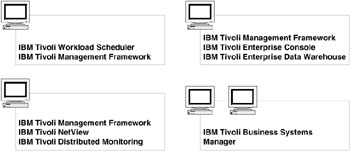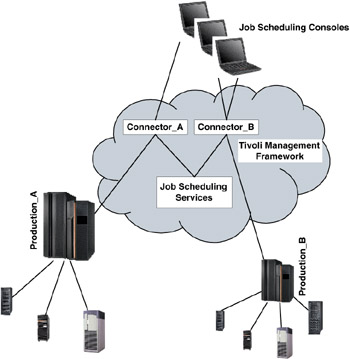1.2 IBM Tivoli Workload Scheduler and IBM Tivoli Management Framework
|
| < Day Day Up > |
|
1.2 IBM Tivoli Workload Scheduler and IBM Tivoli Management Framework
IBM Tivoli Workload Scheduler provides out-of-the-box integration with up to six other IBM products:
-
IBM Tivoli Management Framework
-
IBM Tivoli Business Systems Manager
-
IBM Tivoli Enterprise Console
-
IBM Tivoli NetView
-
IBM Tivoli Distributed Monitoring (Classic Edition)
-
IBM Tivoli Enterprise Data Warehouse
Other IBM Tivoli products, such as IBM Tivoli Configuration Manager, can also be integrated with IBM Tivoli Workload Scheduler but require further configuration not provided out of the box. Best practices call for implementing IBM Tivoli Management Framework on the same Master Domain Manager server used by IBM Tivoli Workload Scheduler.
Figure 1-2 on page 5 shows a typical configuration of all six products, hosted on five servers (IBM Tivoli Business Systems Manager is often hosted on two separate servers).

Figure 1-2: Typical site configuration of all Tivoli products that can be integrated with IBM Tivoli Workload Scheduler out of the box
In this redbook, we show how to configure IBM Tivoli Workload Scheduler and IBM Tivoli Management Framework for high availability, corresponding to the upper left server in the preceding example site configuration. Sites that want to implement other products on an IBM Tivoli Workload Scheduler Master Domain Manager server for high availability should consult their IBM service provider.
IBM Tivoli Workload Scheduler uses IBM Tivoli Management Framework to deliver authentication services for the Job Scheduling Console GUI client, and to communicate with the Job Scheduling Console in general. Two components are used within IBM Tivoli Management Framework to accomplish these responsibilities: the Connector, and Job Scheduling Services (JSS). These components are only required on the Master Domain Manager server.
For the purposes of this redbook, be aware that high availability of IBM Tivoli Workload Scheduler requires proper configuration of IBM Tivoli Management Framework, all Connector instances, and the Job Scheduling Services component.
Figure 1-3 on page 6 shows the relationships between IBM Tivoli Management Framework, the Job Scheduling Services component, the IBM Tivoli Workload Scheduler job scheduling engine, and the Job Scheduling Console.

Figure 1-3: Relationship between major components of IBM Tivoli Workload Scheduler and IBM Tivoli Management Framework
In this example, Job Scheduling Console instances on three laptops are connected to a single instance of IBM Tivoli Management Framework. This instance of IBM Tivoli Management Framework serves two different scheduling networks called Production_A and Production_B via two Connectors called Connector_A and Connector_B. Note that there is only ever one instance of the Job Scheduling Services component no matter how many instances of the Connector and Job Scheduling Console exist in the environment.
It is possible to install IBM Tivoli Workload Scheduler without using the Connector and Job Scheduling Services components. However, without these components the benefits of the Job Scheduling Console cannot be realized. This is only an option if a customer is willing to perform all operations from just the command line interface.
In high availability contexts, both IBM Tivoli Workload Scheduler and IBM Tivoli Management Framework are typically deployed in a high availability environment. In this Redbook, we will show how to deploy IBM Tivoli Workload Scheduler both with and without IBM Tivoli Management Framework.
|
| < Day Day Up > |
|
EAN: 2147483647
Pages: 92